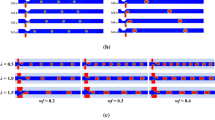Abstract
This paper presents the developments of microfluidic based multidirectional flow sensor inspired from artificial cupula. The proposed flow sensor consists of one-side-electrode and dome-shaped membrane that integrated with microchannel. When the flows impart the dome-shaped membrane, it will displace the liquid inside the microchannel and give changes in capacitance. Computational fluid dynamic analysis for dome structure using ANSYS Fluent software was discussed and compared with the hair structure. The Polydimethylsiloxane material was chosen for main material based on its potential properties to be implemented as a membrane. The micro-stamping technique to form a thin dome-shaped membrane was discussed where the uniform thickness was achieved by using this technique. The experiment was setup for water flow measurement, directionality test and moving object detection. For sensor characterization, the operating frequency and time response of the sensor obtained where respectively to 1.2 kHz and 0.35 s. The sensor was able to measure the flow rate as lower as 10 cm/s in water with the resolution of 5 cm/s. The experiment result also proved that the sensor was capable to detect the flow in multiple directions.
















Similar content being viewed by others
References
Chen N, Tucker C, Engel JM, Yang Y, Pandya S, Liu C (2007) Design and characterization of artificial haircell sensor for flow sensing with ultrahigh velocity and angular sensitivity. J Microelectromech Syst 16(5):999–1014
Coombs S (2001) Smart skins: information processing by lateral line flow sensors. Auton Robots 11(3):255–261
Engelmann J, Hanke W, Bleckmann H (2002) Lateral line reception in still-and running water. J Comp Physiol A 188(7):513–526
Izadi N, de Boer MJ, Berenschot JW, Krijnen GJM (2010) Fabrication of superficial neuromast inspired capacitive flow sensors. J Micromech Microeng 20(8):1–9
Manaf AA, Namakura K, Matsumoto Y (2007) One-side electrode-type fluid-based inclinometer combined with CMOS circuitry. Sensors and Materials 19:417–434
Nawi MNM, Manaf AA, Arshad MR, Sidek O (2013) Fabrication of PDMS dome-shaped membrane and its performance analysis using FEA for fluidic based flow sensor, Presented at International Conference and Exhibition on Sustainable Energy and Advanced Material (ICE-SEAM), 30–31 Oct 2013
Nguyen SD, Paprotny I, Wright PK, White RM (2014), In-plane capacitive MEMS flow sensor for low-cost metering of flow velocity in natural gas pipelines, 2014 IEEE 27th International Conference on Micro Electro Mechanical Systems (MEMS), pp 971–974
Senez V, Lennon E, Ostrovidov S, Yamamoto T, Fujita H, Sakai Y, Fujii T (2008) Integrated 3-D silicon electrodes for electrochemical sensing in microfluidic environments: application to single-cell characterization. IEEE Sens J 8(5):548–557
Suter JD, Hohimer CJ, Fricke JM, Christ J, Kim H, Evans TA (2013) Principles of meniscus-based MEMS gas or liquid pressure sensors. J Microelectromech Syst 22(3):670–677
Tao J, Yu XB (2012) Hair flow sensors: from bio-inspiration to bio-mimicking—a review. Smart Mater Struct 21(11):1–23
Zhang BZ, Qiao H, Chen S, Liu J, Zhang WD, Xiong JJ, Xue CY, Zhang GJ (2008) Modeling and characterization of a micromachined artificial hair cell vector hydrophone. Microsyst Technol 14(6):821–828
Acknowledgments
This work was supported by USM Fellowship grant, Grant Number 1001/PELECT/8023012 and 1001/PELECT/814168. The authors also would like to thank all members of Underwater Robotic Research Group (URRG), USM and School of Electrical and Electronics Engineering for their support and assistance throughout the work.
Author information
Authors and Affiliations
Corresponding author
Rights and permissions
About this article
Cite this article
Nawi, M.N.M., Manaf, A.A., Arshad, M.R. et al. Development of microfluidic based multidirectional flow sensor inspired from artificial cupula. Microsyst Technol 21, 1513–1521 (2015). https://doi.org/10.1007/s00542-014-2286-5
Received:
Accepted:
Published:
Issue Date:
DOI: https://doi.org/10.1007/s00542-014-2286-5




